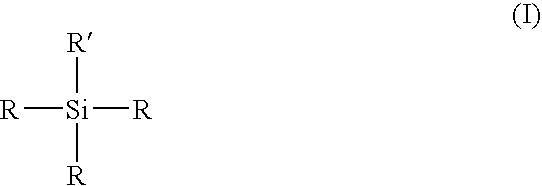Branched polycarbonate resin and process for production thereof
a polycarbonate resin and branched technology, applied in the direction of mixing, chemistry apparatus and processes, etc., can solve the problems of inhibiting stable production, reducing productivity, and unable to obtain satisfactory molded products, and achieve excellent productivity, high melt tension, and efficient production of favorable molded products
- Summary
- Abstract
- Description
- Claims
- Application Information
AI Technical Summary
Benefits of technology
Problems solved by technology
Method used
Image
Examples
example 1
(Oligomer Synthesis Step)
[0044]2000 ppm of sodium dithionite with respect to an amount of bisphenol A to be dissolved later is added to a 5.6 wt % aqueous sodium hydroxide solution, and bisphenol A was dissolved therein such that a bisphenol A concentration became 13.5 wt %, to thereby prepare an aqueous sodium hydroxide solution of bisphenol A.
[0045]The aqueous sodium hydroxidesolution of bisphenol A, methylene chloride, and phosgeneat 40 l / hr, 15 l / hr, and4.0 kg / hr, respectively, were continuously passed through a tube reactor having an inner diameter of 6 mm and a tube length of 30 m. The tube reactor had a jacket part, and a reaction liquid was maintained at 40° C. or lower by passing cooling water through the jacket.
[0046]The reaction liquid flowing out of the tube reactor was continuously introduced into a tank reactor equipped with a sweepback blade and a baffle and having an inner volume of 40 l. Then, the aqueous sodium hydroxide solution of bisphenol A, a 25 wt % aqueous s...
examples 2 to 5
[0055]Example 1 was repeated except that addition amounts of the branching agent and the chain terminating agent (PTBP) were changed in Example 1. Table 1 shows the properties of the obtained polycarbonate.
PUM
| Property | Measurement | Unit |
|---|---|---|
| temperature | aaaaa | aaaaa |
| diameter | aaaaa | aaaaa |
| length | aaaaa | aaaaa |
Abstract
Description
Claims
Application Information
 Login to View More
Login to View More - R&D
- Intellectual Property
- Life Sciences
- Materials
- Tech Scout
- Unparalleled Data Quality
- Higher Quality Content
- 60% Fewer Hallucinations
Browse by: Latest US Patents, China's latest patents, Technical Efficacy Thesaurus, Application Domain, Technology Topic, Popular Technical Reports.
© 2025 PatSnap. All rights reserved.Legal|Privacy policy|Modern Slavery Act Transparency Statement|Sitemap|About US| Contact US: help@patsnap.com



